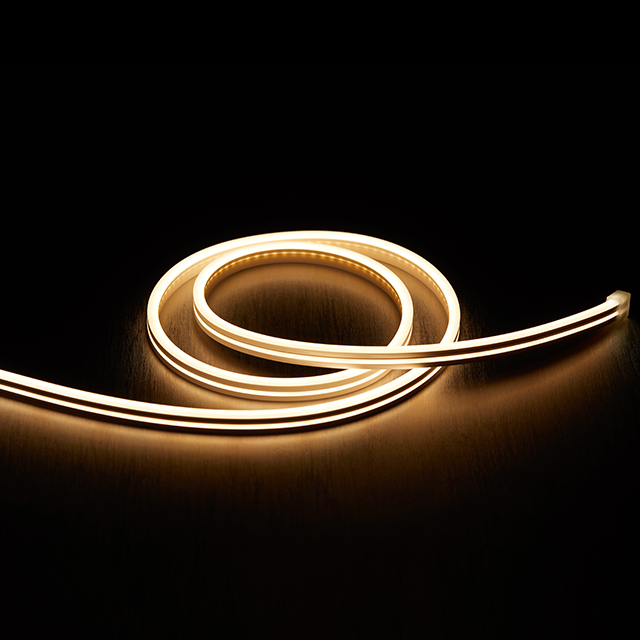Views: 0 Author: Site Editor Publish Time: 2025-04-15 Origin: Site
Have you ever wondered if you can cut neon flex strip light? This versatile lighting solution has become increasingly popular for custom projects. Cutting neon flex strip light is a common question among DIY enthusiasts and professionals alike. It's important to understand how to do it safely and effectively. In this post, we'll discuss whether neon flex strip light can be cut and how to do so properly for your next project.
A neon flex strip light is a flexible, LED-based lighting solution designed to mimic the look of traditional neon lights. Made from a silicone or PVC jacket, it houses LED lights that emit a vibrant, neon-like glow.
Unlike traditional neon lights, which are fragile and hard to install, neon flex strip light is durable, flexible, and easy to work with. It can bend and curve to fit any design or space.
Flexibility: It can be bent or shaped, offering endless creative possibilities.
Energy Efficiency: Neon flex strip light uses LEDs, making it energy-efficient compared to traditional neon.
Ease of Installation: It's lightweight and easy to install, perfect for both DIY and professional projects.
This combination of flexibility and energy savings makes neon flex strip light a popular choice for a wide range of applications, from signage to decorative lighting.
Yes, neon flex strip light can be cut to fit your specific needs. Whether it's for a custom installation or a repair, neon flex strip light offers flexibility in length. This makes it ideal for a wide range of lighting projects, from signage to decorative accents.
When you cut neon flex strip light, you can adjust the length to fit your space or design. This flexibility makes it perfect for both professional and DIY projects.
There are several reasons people cut neon flex strip light:
Customization: Often, the lights need to be adjusted to fit particular spaces or design specifications.
Repair: Over time, a section of the strip might get damaged. Cutting it allows you to replace just that portion.
Creativity: Cutting neon flex strip light opens up possibilities for creating unique shapes, logos, or custom signage.
These factors contribute to the widespread use of neon flex strip light in various industries, especially for creating dynamic, personalized lighting.
Cutting neon flex strip light is safe if done correctly. When you cut along the marked cut points (usually found every 1 to 2 feet), you won't damage the internal LEDs or wiring. The key is to follow the manufacturer's instructions to avoid cutting in the wrong places.
To ensure safety, always disconnect the power before cutting. Use proper tools like scissors or a utility knife for clean cuts. After cutting, you may need to reconnect the pieces with connectors or soldering. Be careful not to damage the silicone or PVC jacket when cutting.
By taking these precautions, neon flex strip light will continue to function as intended, even after it's been customized to fit your needs.

To cut neon flex strip light safely, you'll need a few key tools. Make sure you have:
Sharp utility knife or scissors for clean cuts.
Wire cutters/strippers for trimming wires and preparing connections.
Measuring tools like a ruler or tape measure to ensure accurate cuts.
Soldering iron (if you plan to rejoin sections of the strip).
Heat shrink tubing and heat gun for waterproofing and protecting connections.
Always disconnect the power before cutting neon flex strip light. This ensures safety and prevents accidental short circuits or shocks while handling the strip.
Look for the marked cut lines along the strip. These lines indicate the safe spots for cutting, where you won't damage the internal LEDs. Never cut outside these lines to maintain the functionality of the strip.
Before cutting, measure the space where you plan to install the neon flex strip light. Mark the cutting area with a pencil or tape. Be precise—incorrect measurements could result in waste or improper fit.
Use sharp scissors or a utility knife to cut along the marked line. Ensure a clean and smooth cut to avoid damaging the internal wiring and LEDs. A jagged cut could cause malfunctions or aesthetic issues.
If you want to reconnect cut sections, use a soldering iron to secure the wires. Apply a small amount of solder and ensure solid, reliable connections. For waterproofing, use heat shrink tubing and a heat gun to seal the connections securely.
Yes, neon flex strip light can be bent after cutting. However, be cautious. Bending it too much may damage the internal wiring or LEDs. Always handle the strip gently to preserve its functionality. For smoother bends, consider bending along the flexible areas of the strip to avoid stress on the wires.
When cutting neon flex strip light, you may compromise its waterproof rating. To maintain its protection, sealing is key.
Silicone Sealant: Apply silicone sealant to the exposed areas after cutting. This restores the IP67 waterproof rating, keeping the light safe from moisture.
Heat Shrink Tubing: Use heat shrink tubing around the cut ends. Shrink it with a heat gun to create a tight seal. This protects the cut area from dirt, dust, and water.
Both methods ensure your neon flex strip light stays functional and safe, especially in outdoor settings or damp areas.
After cutting, it's crucial to check the neon flex strip light for any issues to ensure it still works properly.
Check Connections and Soldering: Ensure the connections are secure. If you've soldered the cut sections together, make sure the solder joints are clean and strong.
Test the Functionality: Before installation, test the cut strip. Make sure all LED sections light up as expected. This confirms the cut did not damage the internal wiring or LEDs.
Proper testing and careful soldering help avoid problems during installation, ensuring your neon flex strip light performs well.
Cutting neon flex strip light is safe if you follow the correct steps. Always use the right tools and cut at marked points. Take care to waterproof the cut ends and test the strip before installing. That way, your lights stay bright and working well.
For custom solutions, visit Orient Lighting Co., Ltd.. We offer flexible LED strips, neon lights, and expert support worldwide.
A: Yes, you can solder neon flex strip light to reconnect sections. Use a low-temperature soldering iron and ensure the connections are clean. Apply heat shrink tubing to protect the soldered joints.
A: Yes, after cutting, ensure the exposed ends are sealed with silicone sealant and heat shrink tubing to maintain waterproofing and durability for outdoor use.
A: Measure carefully and mark the cutting line before cutting. Use a sharp utility knife or scissors to ensure a clean, straight cut. Avoid cutting beyond the designated cut points.


